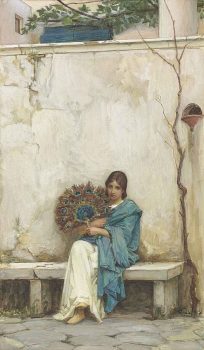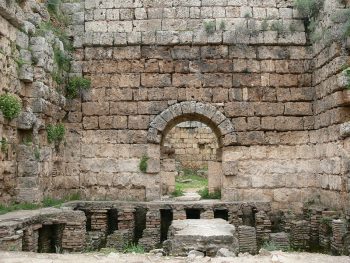How Ancient Romans Beat the Heat Posted by Brittany Britanniae on Aug 30, 2016 in Roman culture, Uncategorized
Salvete Omnes! As we are reaching the last month of Summer, for us in the Northern Hemisphere, we might be seeing a few more heatwaves. So let’s see how the Ancient Romans stayed cool in the summer before air conditioning and electric fans.

“Day Dreams” by John William Waterhouse. (1879). Courtesy of Wikimedia Commons.
Simply staying out of the sun can keep you from overheating on a warm day. One way the Romans, especially women, stayed cool as they went among their daily business was to carry a parasol with them. This parasol was called an umbracula (“a shady place, bower, arbor”).

Illustrations of the private life of the ancient Greeks – with notes and excursuses. Courtesy of Wikimedia Commons.
Perhaps the most common and impressive method of staying cool was by visiting the public baths, particularly one kind of bath known as the frigidarium. A frigidarium was a large cold pool at the baths.

Pompeya. Terme Stabiane. Frigidarium.
Courtesy of Wikimedia Commons.
This was the last pool after a visitor would first go through the caldarium (also called a calidarium, cella caldaria or cella coctilium) and the tepidarium (from “warm” [tepidus]), which were respectively hot and warm rooms used to open the pores. These rooms were constructed in the pillared suspensura style, so that the floor was suspended above an empty space where hot air could circulate and warm the room.

Ancient Roman baths – Tepidarium: Front wall with hypocaustum. Courtesy of Wikimedia Commons.
The cold water of the frigidarium was meant to close the pores, however it would have also been useful by itself on hot days. The water could be also kept cold by using snow.

Snow on Branch. Courtesy of Wikimedia Commons.
Snow was also useful as a way to keep drink cold or to even eat as a refreshing snack on a hot day. Snow was an expensive commodity, especially in the summer, of course. It had been imported in and the richest in Rome could afford to have their own supply of snow. The more general public could purchase snow from shops where the stock of snow was kept in underground storage spaces.
There were other, more extravagant, ways that only the rich, the equites, could afford to beat the heat. Some of the rich could afford homes with special architecture that incorporated water from the aqueducts into the walls to cool their home. This water would then be sourced to the public baths and fountains in the cities as well after taking this detour through the homes of the rich.
However, the most effective way to stay out of the heat was to literally run away from the heat. The rich could afford vacation homes away from the city and closer to the ocean where it was cooler.
The more general public, the plebs, had to suffer the heat in the notoriously stuffy housing called insulae (Latin for “island”). For those stuck in the city they would have to make do with the above alternatives and sweat through the heat.

Remains of the top floors of an insula near the Capitolium and the Aracoeli in Rome. Courtesy of Wikimedia Commons.
Thinking about how Ancient Romans managed to stay cool in the summer might make us all a bit grateful for modern air conditioning, however, we can take these methods in our everyday lives to conserve energy. Instead of a frigidarium we can visit the local pool, we can purchase ice cream or snow cones, and we can carry modern day parasols when we need to leave the house. Let’s all stay cool and hydrated and enjoy the rest of the summer!
Review the Vocab for This Week:
umbracula
frigidarium
caldarium
calidarium
cella caldaria
cella coctilium
tepidarium
tepidus
suspensura
equites
plebs
insulae
Sources:
Sergius Orata: Inventor of the Hypocaust? Garrett G. Fagan. Vol. 50, No. 1 (Spring, 1996), pp. 56-66.
Thermal Delight in Architecture. Lesa Heschong. MIT Press. 1979.
Everyday Life in Ancient Rome. Lionel Casson. JHU Press, 1998.

Build vocabulary, practice pronunciation, and more with Transparent Language Online. Available anytime, anywhere, on any device.
About the Author: Brittany Britanniae
Hello There! Please feel free to ask me anything about Latin Grammar, Syntax, or the Ancient World.




Comments:
Meridian:
Love these “everyday life” posts – thanks!